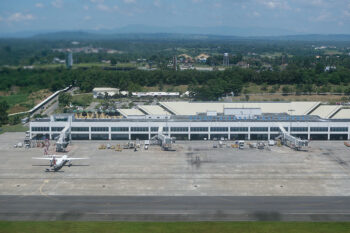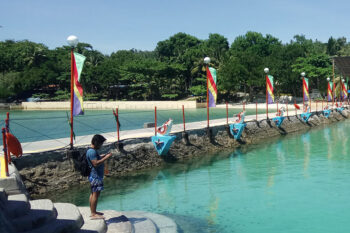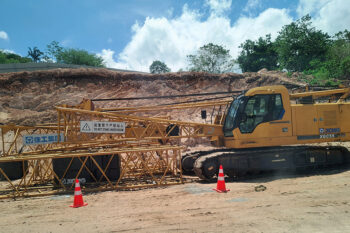There has been no end to the bad news coming our way recently. On Sunday, December 15, the strongest earthquake (at magnitude 6.9) rocked most of the areas in south Mindanao, especially Davao del Sur. Buildings toppled even as there are cracks in many others. Households lost their houses, children got traumatized. As of last count, eight perished with this recent disaster, the kind of which happened a few times last October also hitting south Mindanao. As I write this, there have been a number of aftershocks.
A lot of bad news have been reported elsewhere. Early in December, the north of this Republic got hit by another typhoon—named locally as Tisoy—and once more causing a lot of suffering to those affected. With flights and boat trips cancelled, thousands were inconvenienced. In Metro Manila, the citizens—especially in communities constantly affected by water shortage—wonder if things will get worse as the State and the oligarchic water firms are locked in a dispute which eventually will lead to elephants’ will trampling down on the millions of ants underneath. Once more (the fourth), another corruption case against the Marcoses was dismissed by the Sandiganbayan for lack of sufficient evidence. (Although one wonders if it is due to the inefficiency of the PCGG, or is it because part of the billions of the Marcos loot made its way to some influential people’s pockets.)
Bad news were also reported elsewhere. In New Zealand, a volcano erupted. In London, Boris Johnson won the recent elections leading to Brexit, angering those opposed to this move. One more populist government on the rise! In a few other countries—from Lebanon to Chile—people took to the streets to protest State corruption. In Madrid, the negotiators from almost 200 nations attending the UN climate meeting failed to agree in taking steps to curb the rise of greenhouse gas emissions to prevent global temperatures rising more than 1.5 degrees Celsius by the end of the century.
As the Christmas season unfolded, we have been hoping for good news! Few blessings did come. The Philippines ended a dismal 14-year record at the Southeast Asian games of ending at the bottom. This time, our athletes won the most number of gold, silver and bronze medals, thus making the Philippines the champion. (One can only hope that with the euphoria following this victory, there will be no whitewashing of the corruption cases that have been filed against those who pocketed some of the funds.) And after 10 years, the Quezon City Trial Court found Andal Ampatuan Jr., his siblings and kin, and 23 others guilty of the massacre of mostly media people and have been sentenced to reclusion perpetua. Then there is the naming of teenage climate activist Greta Thunberg as Time’s Person of the Year. Once more like the brave Hong Kong youth, a growing number of young people are taking a stand to deal with urgent socio-political and ecological issues.
Comes now the news that the buklog—the Subanen complex ritual—has been added by the United Nations Educational, Scientific and Cultural Organization (Unesco) to its list of Intangible Cultural Heritage in Need of Urgent Safeguarding to prevent it from being forgotten. For the majority of Mindanawons, this may not strike them as particularly newsworthy! But that only manifests their ignorance in terms of the richness of our indigenous cultures, in particular the one of the Subanens of the Zamboanga peninsula.
For those who have been lucky to experience even just one buklog, the memory of being at the ritual will remain etched in their minds for years. This is especially so, if the buklog takes place from morning till night when there is a full moon. One has to experience attending such a ritual to fully appreciate its value and significance, especially for the members of a Subanen community. Unlike some rituals that can lost only a few hours, this can go on for days depending on the available resources and provisions for food and drink. Its complexity is constituted from setting up the space for the ritual to the meanings of the symbols used to the reasons why a buklog takes place. There are actually a number of rituals constituting the entire buklog. The first one begins when permission is sought from the spirits in cutting trees that would serve as poles for a platform which serves as stage.
Another ritual follows with the gathering of dulugan, the springy wood from the nearby forest. Its branches are then held together by rattan to serve as flooring of the platform without the need for nails. The interweaving of the branches must be so done so that it becomes strong enough to support a lot of weight as 10 to 25 people stand and dance without breaking the platform. This dancing—known as gbat—is done by everyone from children to the elderly and goes on and on to the music of the agong and the kulintang. As there are those who dance, the others seated at the edge of the platform cheer them.
Once the platform is set up and provisions are made available, other rituals can take place like rituals to thank for a good harvest, or seeking healing for the sick as well as honoring the dead. As such, the buklog functions as the community’s unifying force. It provides them with the occasion for a rousing celebration that help cement inter-relationships between families and clans. It could even be occasions for conflict resolution. Not only does it ensure harmony among members of the community but among the human, natural and spiritual worlds. As young people are drawn to this celebration, it can also serve as a discreet courtship dance.
There is, however, a shadow hovering over the buklog despite the Unesco move. As can easily be ascertained, this ritual relies a lot on natural resources for it to survive. Most of the essential elements needed for this ritual comes from the forest, from the trees that serve as posts of the platform to the dulugan and rattan. Symbols used—such as animals and betel nuts—are also gifts of the forests. As deforestation has led to the disappearance of primal forests, many of these elements are now rare, if at all available. Where before food provisions would also be provided through the hunting in the forests, today most food to be served have to be bought, making the buklog quite expensive to conduct.
Then there is the question of the people’s security both in terms of being able to remain in their ancestral territory as well as not experiencing harassment from elements that violate their human rights. Both are factors that could force them to evacuate and be dislocated from their ancestral abode. For as long as the Subanens are secured in their ancestral domain with their cultural heritage intact, they do wish to conduct the buklog regularly. But with the onslaught of mining explorations across the peninsula, there is fear that more Lumad dislocations will follow.
If deforestation is left unchecked and all forests disappear across the Zamboanga peninsula and the Subanen peoples are subjected to all kinds of pressures that would force them to leave their ancestral domain, then no amount of Unesco listing would assure that the buklog will continue to take place in this part of the planet!
[Redemptorist Brother Karl Gaspar is a professor at St. Alphonsus Theological and Mission Institute (SATMI) in Davao City and a professor of Anthropology at the Ateneo de Davao University. Gaspar is author of several books, including “Desperately Seeking God’s Saving Action: Yolanda Survivors’ Hope Beyond Heartbreaking Lamentations,” two books on Davao history, and “Ordinary Lives, Lived Extraordinarily – Mindanawon Profiles” launched in February 2019. He writes two columns for MindaNews, one in English (A Sojourner’s Views) and the other in Binisaya (Panaw-Lantaw).]







